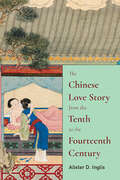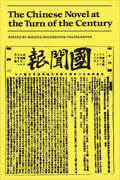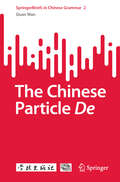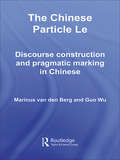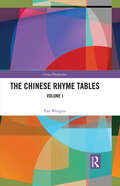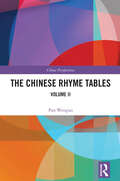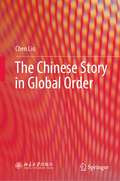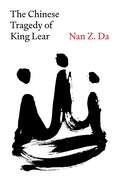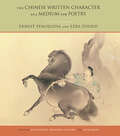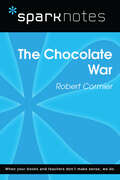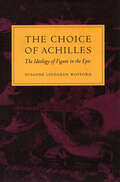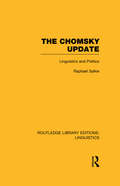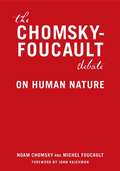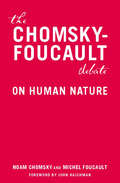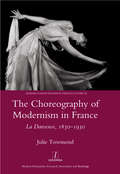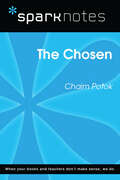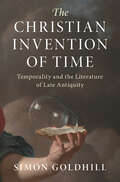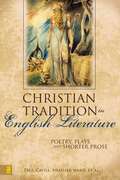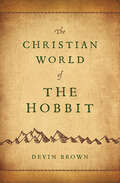- Table View
- List View
The Chinese Lexicon: A Comprehensive Survey
by Yip Po-ChingThe Chinese Lexicon is a detailed study of the words and word combinations used in modern Chinese. Yip Po-Ching defines the general properties of a language's lexicon, or vocabulary, prior to a thorough discussion of the organizational features of the Chinese lexicon. Comparisons are made between Chinese and English, highlighting the similarities and differences between the two lexicons. This fascinating work examines the relationships between word and meanings, and demonstrates the ability of language to combine continuity and change. It surpasses the scope of a dictionary and reveals the systematic nature of vocabulary. Features include: a wealth of language examples clear comparisons between Chinese and English Chinese characters and pinyin romanization throughout a comprehensive index. The Chinese Lexicon surpasses the scope of a dictionary and reveals the systematic nature of vocabulary. It will prove an invaluable resource for all students and teachers of Chinese.
The Chinese Love Story from the Tenth to the Fourteenth Century (SUNY series in Chinese Philosophy and Culture)
by Alister D. InglisLove stories formed a major part of the classical short story genre in China from as early as the eighth century, when men of letters began to write about romantic encounters. In later centuries, such stories provided inspiration for several new literary genres. While much scholarly attention has been focused on the short story of both the medieval and late imperial eras, comparatively little work has been attempted on the interim stage, the Song and Yuan dynasties, which spanned some five hundred years from the tenth to the fourteenth centuries. Yet this was a crucial developmental period for many forms of narrative literature—so much so that any understanding of late imperial narrative should be informed by the earlier tradition. The first study of its kind in English, The Chinese Love Story from the Tenth to the Fourteenth Century traces the development of the love story throughout this important yet overlooked era. Using Tang dynasty stories as a point of comparison, Alister D. Inglis examines and appraises key new themes, paying special attention to period hallmarks, gender portrayal, and textuality. Inglis demonstrates that, contrary to received scholarly wisdom, this was a highly innovative period during which writers and storytellers laid a fertile foundation for the literature of late imperial China.
The Chinese May Fourth Generation and the Irish Literary Revival: Writers and Fighters (Asia-Pacific and Literature in English)
by Simone O’Malley-SuttonThis book examines how the early twentieth-century Irish Renaissance (Irish Literary Revival) inspired the Chinese Renaissance (the May Fourth generation) of writers to make agentic choices and translingual exchanges. It sheds a new light on “May Fourth” and on the Irish Renaissance by establishing that the Irish Literary Revival (1900-1922) provided an alternative decolonizing model of resistance for the Chinese Renaissance to that provided by the western imperial center. The book also argues that Chinese May Fourth intellectuals translated Irish Revivalist plays by W. B. Yeats, Lady Gregory, Seán O’Casey and Synge and that Chinese peasants performed these plays throughout China during the 1920s and 1930s as a form of anti-imperial resistance. Yet this literary exchange was not simply going one way, since Yeats, Lady Gregory, Synge and O’Casey were also influenced by Chinese developments in literature and politics. Therefore this was a reciprocal encounter based on the circulation of Anti-colonial ideals and mutual transformation.
The Chinese Novel at the Turn of the Century
by Milena Dolezelova-VelingerovaThis collection of essays reveals the dynamic role of the late Qing novel in the process of modernization of Chinese fiction. Substantial changes in various aspects of the Chinese novel at the turn of the century, demonstrated by structural analyses of several representative novels, suggest that the evolution of modern Chinese fiction was a more complex process than a simple imitation of Western literatures. The results challenge the scholarly consensus that modern Chinese fiction resulted from a radical change brought about by the May Fourth Movement in 1919. It is demonstrated rather that the transformation had already begun in the first decade of the twentieth century and that the conspicuous changes in Chinese fiction of the 1920s represent a culmination rather than a beginning of the modern evolutionary process. The book consists of nine studies which analyse the late Qing novel in its general and specific aspects. The introduction and first essay explain how social changes conditioned cultural and literary changes during the period and how the resultant new theory of fiction generated new concepts of a politically engaged novel. The two following studies develop a general statement of narrative structures and devices, derived from structural analyses of seven outstanding late Qing novels. The last six articles examine particular novels in detail, focusing on the specific fictional techniques which predominate in each. This is the first volume in a new series, Modern East Asian Studies.
The Chinese Particle De (SpringerBriefs in Chinese Grammar #2)
by Quan WanThis book indicates that the nature and function of de is one of the core issues in the study of Chinese grammar. There are many related studies, which are not only a long-term controversial and difficult problem, but also a theoretical issue that constantly invites the renewal of research methods. This book mainly focuses on the following aspects, summarizes the achievements of the previous studies, and expounds the possible research directions in the future: 1. How many morphemes can de be analyzed into? 2. Is the basic function of the attributive containing the word de qualitative or descriptive? 3. What determines the presence and distribution of de? What is the Reference-Object Construction? 4. Can the theory of endocentric construction be used to analyze de? 5. Is de a nominalizer? What is the relationship between the self-designation and the transferred designation of de? How to treat the construction "N de V"? 6. Is de a tense-aspect auxiliary in the event sentences "V de O" and "VO de"? What is the function of the sentence final de? Is de a modal particle? 7. The issues of pseudo-attributive vs. quasi-attributive in understanding de.
The Chinese Particle Le: Discourse Construction and Pragmatic Marking in Chinese (Routledge Studies in Asian Linguistics)
by M.E. van den Berg G. WuEver since the start of Chinese linguistic studies, the description of the Chinese particle LE has remained elusive. The classification has evolved from a listing of sentences and the discussion of contrastive pairs to a more context and discourse-oriented analysis. The development in recent years of inferential models and situation semantics has opened the way for a renewed study of the use of the Chinese particle LE. This book discusses the Chinese data from a 'mental space' perspective and finally reveals the role so-called Chinese 'sentence LE' plays in the construction and maintenance of discourse.
The Chinese Rhyme Tables: Volume I (China Perspectives)
by Pan WenguoAs the first volume of a two-volume set that studies Chinese rhyme tables, this book focuses on their emergence, development, structure, and patterns. Rhyme tables are tabulated tool constituted by phonological properties, which helps indicate the pronunciation of sinograms or Chinese characters, marking a precise and systematic account of the Chinese phonological system. This volume first discusses the emergence of the model and factors that determined its formation and evolution, including the Chinese tradition of the rhyme dictionary and the introduction of Buddhist scripts. The second part analyzes the structure and arrangement patterns of rhyme tables in detail, giving insights into the nature of “division” (deng): the classification and differentiation of speech sounds, of vital significance in the reconstruction of middle Chinese. The author argues that deng has nothing to do with vowel aperture or other phonetic features but is a natural result of rhyme table arrangement. He also reexamines the principles for irregular cases (menfa rules) and categorizes the 20 rules into three types.The book will appeal to scholars and student studying linguistics, Chinese phonology, and Sinology.
The Chinese Rhyme Tables: Volume II (China Perspectives)
by Pan WenguoAs the second volume of a two-volume set that studies the Chinese rhyme tables, this book seeks to reconstruct the ancient rhyme tables based on the extant materials and findings. A rhyme table is a tabulated tool constituted by phonological properties, which helps indicate the pronunciation of sinograms or Chinese characters, marking an accurate and systematic account of the Chinese phonological system. The book first explores the relationship and identifies the prototype of the extant rhyme tables. Then the principles and methods for collating and rebuilding the ancient rhyme table are introduced. It then looks at the general layout, including tables, table order, shè, zhuǎn, rhyme heading, rhyme order, light and heavy articulations, rounded and unrounded articulations, and initials. The final chapter presents the reconstructed rhyme tables with detailed annotations and add-on indexes. The book will appeal to scholars and students studying Sinology, Chinese linguistics, and especially Chinese phonology.
The Chinese Story in Global Order
by Chen LiuThis book provides a historical review of the transformation of China’s image around the world since the 1978 Reform and Opening Up. Based on a synthetic model that the author constructs for evaluating national images, together with a historical review and quantitative analysis, it discusses the issues and challenges confronting China’s image around the world since the Opening Up. To help rectify the situation that most of the research on China’s reform efforts focuses on hard power (esp. economic power), this book, which mainly focuses on China’s soft power, reviews and assesses its global image from the three perspectives of politics, economy and culture. In the process, it sheds valuable new light on the presentation of China’s image and the world’s perceptions of China.
The Chinese Tragedy of King Lear
by Nan Z. DaA compelling new reading of The Tragedy of King Lear that finds parallels in twentieth-century Chinese historyAt the start of Shakespeare&’s famous tragedy, King Lear promises to divide his kingdom based on his daughters&’ professions of love, but portions it out before hearing all of their answers. For Nan Da, this opening scene sparks a reckoning between The Tragedy of King Lear, one of the cruelest and most confounding stories in literature, and the tragedy of Maoist and post-Maoist China. Da, who emigrated from China to the United States as a child in the 1990s, brings Shakespeare&’s tragedy to life on its own terms, addressing the concerns it reflects over the transition from Elizabeth I to James I with a fearsome sense of what would soon come to pass. At the same time, she uses the play as a lens to revisit the world of Maoist China—what it did to people, and what it did to storytelling. Blending literary analysis and personal history, Da begins in her childhood during Deng Xiaoping&’s Opening and Reform, then moves back and forth between Lear and China. In her powerful reading, the unfinished business of Maoism and other elements of Chinese thought and culture—from Confucianism to the spectacles of Peking Opera—help elucidate the choices Shakespeare made in constructing Lear and the unbearable confusions he left behind.
The Chinese Written Character as a Medium for Poetry: A Critical Edition
by Jonathan Stalling Ernest Fenollosa Ezra Pound Lucas KleinFirst published in 1919 by Ezra Pound, Ernest Fenollosa’s essay on the Chinese written language has become one of the most often quoted statements in the history of American poetics. As edited by Pound, it presents a powerful conception of language that continues to shape our poetic and stylistic preferences: the idea that poems consist primarily of images; the idea that the sentence form with active verb mirrors relations of natural force. But previous editions of the essay represent Pound’s understanding—it is fair to say, his appropriation—of the text. Fenollosa’s manuscripts, in the Beinecke Library of Yale University, allow us to see this essay in a different light, as a document of early, sustained cultural interchange between North Americaand East Asia.Pound’s editing of the essay obscured two important features, here restored to view: Fenollosa’s encounter with Tendai Buddhism and Buddhist ontology, and his concern with the dimension of sound in Chinese poetry.This book is the definitive critical edition of Fenollosa’s important work. After a substantial Introduction, the text as edited by Pound is presented, together with his notes and plates. At the heart of the edition is the first full publication of the essay as Fenollosa wrote it, accompanied by the many diagrams, characters, and notes Fenollosa (and Pound) scrawled on the verso pages. Pound’s deletions, insertions, and alterations to Fenollosa’s sometimes ornate prose are meticulously captured, enabling readers to follow the quasi-dialogue between Fenollosa and his posthumous editor. Earlier drafts and related talks reveal the developmentof Fenollosa’s ideas about culture, poetry, and translation. Copious multilingual annotation is an important feature of the edition.This masterfully edited book will be an essential resource for scholars and poets and a starting point for a renewed discussion of the multiple sources of American modernist poetry.
The Chocolate War (SparkNotes Literature Guide Series)
by SparkNotesThe Chocolate War (SparkNotes Literature Guide) by Robert Cormier Making the reading experience fun! Created by Harvard students for students everywhere, SparkNotes is a new breed of study guide: smarter, better, faster.Geared to what today's students need to know, SparkNotes provides:chapter-by-chapter analysis explanations of key themes, motifs, and symbols a review quiz and essay topics Lively and accessible, these guides are perfect for late-night studying and writing papers.
The Choice of Achilles
by Susanne Lindgren WoffordThis book examines the ways that Classical and Renaissance epic poems often work against their expressed moral and political values. It combines a formal and tropological analysis that stresses difference and disjunction with a political analysis of the epic's figurative economy. It offers an interpretation of three epic poems - Homer's Iliad, Virgil's Aeneid, and Spencer's Faerie Queene - that focuses on the way these texts make apparent the aesthetic, moral, and political difference that constitutes them, and sketches, in conclusion, two alternative resolutions of such division in Milton's Paradise Lost and Cervantes' Don Quixote, an 'epic' in prose. The book outlines a theory of how and why epic narrative may be said to subvert certain of its constitutive claims while articulating a cultural argument of which it becomes the contradictory paradigm. The author focuses on the aesthetic and ideological work accomplished by poetic figure in these narratives, and understands ideology as a figurative, substitutive system that resembles and uses the system of tropes. She defines the ideological function of tropes in narrative and the often contradictory way in which narratives acknowledge and seek to efface the transformative functions of ideology. Beginning with what it describes as a dual tendency within the epic simile (toward metaphor in the transformations of ideology; toward metonymy as it maintains a structure of difference), the book defines the politics of the simile in epic narrative and identifies metalepsis as the defining trope of ideology. It demonstrates the political and poetic costs of the structural reliance of allegorical narrative on catachresis and shows how the narrator's use of prosopopoeia to assert political authority reshapes the figurative economy of the epic. The book is particularly innovative in being the first to apply to the epic the set of questions posed by the linking of the theory of rhetoric and the theory of ideology. It argues that historical pressures on a text are often best seen as a dialectic in which ideology shapes poetic process while poetry counters, resists, figures, or generates the tropes of ideology itself.
The Chomsky Effect: A Radical Works Beyond the Ivory Tower
by Robert F. Barsky"People are dangerous. If they're able to involve themselves in issues that matter, they may change the distribution of power, to the detriment of those who are rich and privileged." --Noam Chomsky. Noam Chomsky has been praised by the likes of Bono and Hugo Chavez and attacked by the likes of Tom Wolfe and Alan Dershowitz. Groundbreaking linguist and outspoken political dissenter--voted "most important public intellectual in the world today" in a 2005 magazine poll--Chomsky inspires fanatical devotion and fierce vituperation. In "The Chomsky Effect," Chomsky biographer Robert Barsky examines his subject's positions on a number of highly charged issues--Chomsky's signature issues, including Vietnam, Israel, East Timor, and his work in linguistics--that illustrate not only "the Chomsky effect" but also "the Chomsky approach." Chomsky, writes Barsky, is an inspiration and a catalyst. Not just an analyst or advocate, he encourages people to become engaged--to be "dangerous" and challenge power and privilege. The actions and reactions of Chomsky supporters and detractors and the attending contentiousness can be thought of as "the Chomsky effect." Barsky discusses Chomsky's work in such areas as language studies, media, education, law, and politics, and identifies Chomsky's intellectual and political precursors. He charts anti-Chomsky sentiments as expressed from various standpoints, including contemporary Zionism, mainstream politics, and scholarly communities. He discusses Chomsky's popular appeal--his unlikely status as a punk and rock hero (Eddie Vedder of Pearl Jam is one of many rock and roll Chomskyites)--and offers in-depth analyses of the controversies surrounding Chomsky's roles inthe "Faurisson Affair" and the "Pol Pot Affair." Finally, Barsky considers the role of the public intellectual in order to assess why Noam Chomsky has come to mean so much to so many--and what he may mean to generations to come.
The Chomsky Update: Linguistics And Politics (Routledge Library Editions: Linguistics)
by Raphael SalkieNoam Chomsky has been described as ‘arguably the most important intellectual alive’. His revolutionary work in linguistics has aroused intense scholarly interest, while his trenchant critique of United States foreign policy and his incisive analysis of the role of intellectuals in modern society have made him a prominent public figure. Raphael Salkie’s timely book introduces the two parts of Chomsky’s work and explores the connections between them. He provides an accessible and up-to-date introduction to Chomsky’s linguistics, laying out his basic assumptions and aims – in particular, his consistent drive to make linguistics a science – and looking at a sample of Chomsky’s recent work. He examines the implications for other fields such as philosophy and psychology, as well as the main challenges to Chomsky’s position. Raphael Salkie also sets out the key themes in Chomsky’s political writings and his libertarian socialist views. He contrasts the ‘official line’ on US foreign policy – the view that the US is a ‘well-meaning, blundering giant’ – with Chomsky’s carefully argued alternative view. By focusing on Chomsky’s conception of human nature and human freedom the author draws out the links between the two sides of Chomsky’s work, in the belief that both sides raise issues which can profitably be explored. The author also provides a carefully annotated guide to further reading. As an experienced teacher of linguistics with a commitment to political activism, Raphael Salkie is uniquely qualified to present this introduction to one of the seminal thinkers of our time. First published in 1990.
The Chomsky-Foucault Debate: On Human Nature
by Noam Chomsky Michel FoucaultTwo of the twentieth century's most influential thinkers debate a perennial question. In 1971, at the height of the Vietnam War and at a time of great political and social instability, two of the world's leading intellectuals, Noam Chomsky and Michel Foucault, were invited by Dutch philosopher Fons Edlers to debate an age-old question: is there such a thing as "innate" human nature independent of our experiences and external influences? The resulting dialogue is one of the most original, provocative, and spontaneous exchanges to have occurred between contemporary philosophers, and above all serves as a concise introduction to their basic theories. What begins as a philosophical argument rooted in linguistics (Chomsky) and the theory of knowledge (Foucault), soon evolves into a broader discussion encompassing a wide range of topics, from science, history, and behaviorism to creativity, freedom, and the struggle for justice in the realm of politics. In addition to the debate itself, this volume features a newly written introduction by noted Foucault scholar John Rajchman and includes additional text by Noam Chomsky.
The Chomsky-Foucault Debate: On Human Nature
by Noam Chomsky Michel FoucaultIn this historic 1971 debate, two of the twentieth century&’s most influential thinkers discuss whether there is such a thing as innate human nature. In 1971, at the height of the Vietnam War and at a time of great political and social instability, two of the world&’s leading intellectuals, Noam Chomsky and Michel Foucault, were invited by Dutch philosopher Fons Elders to debate an age-old question: Is there such a thing as &“innate&” human nature independent of our experiences and external influences? The resulting dialogue is one of the most original, provocative, and spontaneous exchanges to have occurred between contemporary philosophers. Above all, their discussion serves as a concise introduction to their two opposing theories. What begins as a philosophical argument rooted in linguistics (Chomsky) and the theory of knowledge (Foucault), soon evolves into a broader discussion encompassing a wide range of topics, from science, history, and behaviorism to creativity, freedom, and the struggle for justice in the realm of politics. In addition to the debate itself, this volume features a newly written introduction by noted Foucault scholar John Rajchman and includes substantial additional texts by Chomsky and Foucault. &“[Chomsky is] arguably the most important intellectual alive.&” —The New York Times &“Foucault . . . leaves no reader untouched or unchanged.&” —Edward Said
The Choreography of Modernism in France: La Danseuse 1830-1930
by Julie Townsend"Whether in the pages of a trashy novel, in the glow of gaslights, in a dance hall, or on the walls of art galleries, the figure of the female dancer haunts nineteenth-century French culture. Artists and writers of all kinds took on la danseuse as an emblem of their own artistic prowess. They represented her alternately as an elusive ideal, a saucy prostitute, or a dangerous seductress. Dancers, in turn, produced their own images, novels and autobiographies, thereby contributing to an ongoing cultural debate around performance, spectatorship, desire, and art. In this interdisciplinary study of la danseuse, Julie Townsend examines the rise and fall of classical ballet, the phenomenon of the music hall, and the birth of modern dance. She highlights moments of representational crisis and emergent aesthetics in her consideration of poetry, novels, painting, early film, and women's autobiography."
The Chosen (SparkNotes Literature Guide Series)
by SparkNotesThe Chosen (SparkNotes Literature Guide) by Chaim Potok Making the reading experience fun! Created by Harvard students for students everywhere, SparkNotes is a new breed of study guide: smarter, better, faster.Geared to what today's students need to know, SparkNotes provides:chapter-by-chapter analysis explanations of key themes, motifs, and symbols a review quiz and essay topics Lively and accessible, these guides are perfect for late-night studying and writing papers.
The Christian Imagination: The Practice of Faith in Literature and Writing
by Leland RykenThe Christian Imagination brings together in a single source the best that has been written about the relationship between literature and the Christian faith. This anthology covers all of the major topics that fall within this subject and includes essays and excerpts from fifty authors, including C.S. Lewis, Flannery O'Connor, Dorothy Sayers, and Frederick Buechner.
The Christian Invention of Time: Temporality and the Literature of Late Antiquity (Greek Culture in the Roman World)
by Simon GoldhillTime is integral to human culture. Over the last two centuries people's relationship with time has been transformed through industrialisation, trade and technology. But the first such life-changing transformation – under Christianity's influence – happened in late antiquity. It was then that time began to be conceptualised in new ways, with discussion of eternity, life after death and the end of days. Individuals also began to experience time differently: from the seven-day week to the order of daily prayer and the festal calendar of Christmas and Easter. With trademark flair and versatility, world-renowned classicist Simon Goldhill uncovers this change in thinking. He explores how it took shape in the literary writing of late antiquity and how it resonates even today. His bold new cultural history will appeal to scholars and students of classics, cultural history, literary studies, and early Christianity alike.
The Christian Tradition in English Literature: Poetry, Plays, And Shorter Prose
by Heather Ward Paul CavillFeatures:• Wide chronological coverage of English literature, especially texts found in the Norton, Oxford, Blackwell and other standard anthologies• Short, punchy essays that engage with the texts, the critics, and literary and social issues• Background and survey articles• Glossaries of Bible themes, images and narratives• Annotated bibliography and questions for class discussion or personal reflection• Scholarly yet accessible, jargon-free approach – ideal for school and university students, book groups and general readersCreated for readers who may be unfamiliar with the Bible, church history or theological development, it offers an understanding of Christianity’s key concepts, themes, images and characters as they relate to English literature up to the present day.
The Christian World of The Hobbit
by Devin BrownIn his beloved story, The Hobbit, J.R.R. Tolkien takes readers into a world unlike any other, yet so much seems familiar. As Bilbo journeys there and back again, glimpses of the spiritual are seen. Previous guides to Tolkien's fiction have often made one of two wrong turnings: either they have entirely overlooked the Christian elements or they have claimed to find "Christian" elements everywhere, going far beyond the fundamental aspects that have been absorbed into the story. The Christian World of The Hobbit does what no book has done: it brings Tolkien fans new delight by introducing a side of Tolkien that is rarely explored but vitally important to his writings--especially to The Hobbit. Written by internationally regarded Tolkien scholar, Devin Brown, this approachable, witty, and highly entertaining. Click here to download the FREE Study Guide.
The Christian Writer's Manual of Style
by Robert HudsonAn essential tool for writers, editors, proofreaders, designers, copywriters, production managers, and marketers too. The Christian Writer’s Manual of Style is an essential tool not only for writers of religious materials, but for their editors, proofreaders, designers, copywriters, production managers, and even marketers. Rather than simply repeating style information commonly available in standard references, this newly updated and expanded edition includes points of grammar, punctuation, usage, book production and design, and written style that are often overlooked in other manuals. It focuses on information relating to the unique needs and demands of religious publications, such as discussions on how to correctly quote the Bible, how to capitalize and use common religious terms, and how to abbreviate the books of the Bible and other religious words. Also included are rarely found items such as: • an author’s guide to obtaining permissions • guidelines for using American, British, and Mid-Atlantic styles • discussions of inclusive language, profanity, and ethnic sensitivities • discussions of Internet and computer-related language style • a list of problem words • style issues regarding words from major world religions • a discussion of handling brand names in text • a list of common interjections • issues of type design, paper, copy-fit This edition has been completely updated since the 1988 edition and contains more than twice as much information as the previous edition. This is the most detailed and comprehensive guide of its kind.

